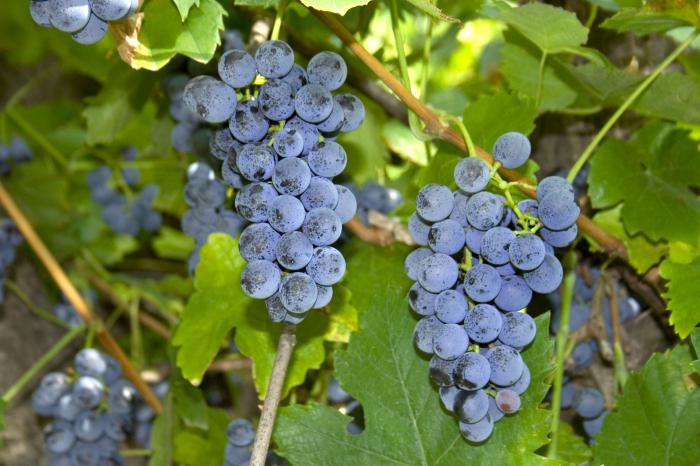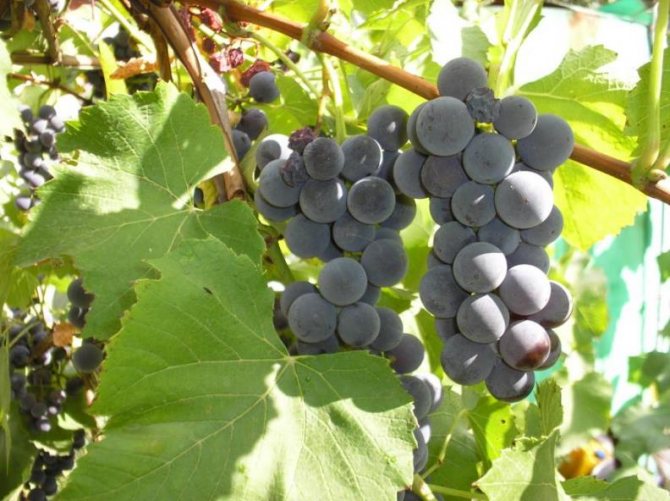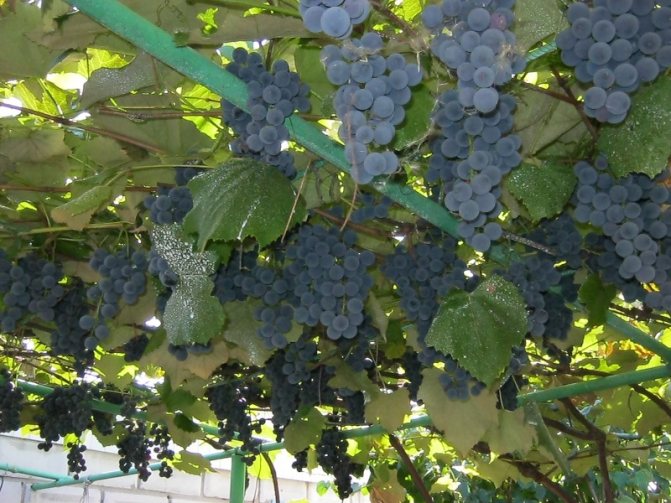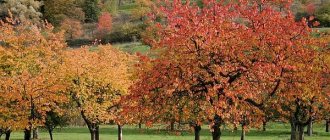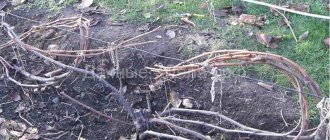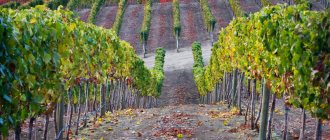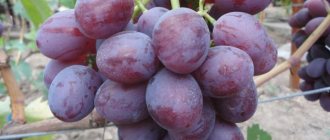The Isabella grape has a long history. It first appeared more than 200 years ago on the North American continent, where local breeder William Prince developed a new crop by crossing the varieties Vytis Vinifera and Vytis Labrusca. At first, the table-technical hybrid was widespread in the farms of the United States and Europe, but later winemakers found the variety unsuitable for making wine due to the content of methyl alcohol and stopped growing the culture.
Our compatriots, despite the warnings of foreign farmers, continue to plant Isabella grapes and prepare excellent homemade wine from her berries. Therefore, today we will discuss the topic "Isabella grapes: planting and care."
In order for the vineyards to give high yields, the summer resident needs to perform three main steps:
- Find a place to set up a vineyard.
- Process the soil.
- Purchase quality seedlings.
The site for planting Isabella grapes should be sunny and calm. In general, this variety is unpretentious and can grow in any conditions. But for the sake of rich harvests, it's still better to try to find a quiet open area. So that the vine can trail freely, it is advisable to place the seedlings along the fence (not end-to-end) or make a special support for them - a trellis.
Preparing the soil for planting is to assess the quality of the soil. If it is clayey, the owner must provide drainage for the vineyard. If the area is dominated by peat bogs, they are diluted with sand. Sandy soil is fertilized with manure or compost, acidic is mixed with lime. Remember that grape seedlings do not like areas with stagnant groundwater and salt marshes.
It is better to buy seedlings in the fall, when the Isabella variety shows its qualities as much as possible. If you plant the bushes right away, they will develop next year and will please the gardener with the harvest earlier.
If the seller offers elite seedlings and grade 1 material, you should pay attention to the number and location of the roots. Elite varieties have 4 or more roots, evenly spaced at the stem, and a mature growth of at least 25 cm in length. The first-class planting material, as a rule, has 4 roots of different thickness and at least one growth of at least 20 cm in length.
After completing the preparatory work, they begin to plant Isabella's seedlings. The month for this work is chosen taking into account the climatic zone, but experts do not prohibit planting and primary care of Isabella grapes in the Moscow region and other regions of the country in the autumn months and even advise planting young bushes in the fall. With this approach, the chances of survival of young animals increase.
How is the planting of Isabella grapes:
- After purchase, the seedlings are soaked in water for 24 hours and the roots are slightly shortened.
- Pits for bushes are dug 80 x 80 x 80 cm in size with a deepening of 20 - 30 cm. If there are many plantings, wells are made at a distance of 1 - 1.5 m from each other.
- A peg is placed in the center of each hole.
- At the bottom of the wells, a drainage system is created in the form of a layer of crushed stone or gravel with a thickness of 8-10 cm.
- The drain is covered with a 10 cm layer of earth and watered abundantly.
- Fertilizer is spread on top (3 buckets of manure or humus) and a mixture of superphosphate, potassium salt and ash (300 g, 100 g and one shovel, respectively).
- The wells are covered with soil and watered. Hillocks are formed around the pegs.
- The seedlings are attached to sticks and the shoots and roots are spread around the tubercle so that the point of divergence of the shoots is flush with the ground.
- The seedlings are buried in soil and compacted by hand.
- A layer of peat and humus is spread around the plantings.
As it grows, the vine will need support. The best option for this purpose is a metal rod.
Here is another landing option shown in the video below.
Watering
Any grape loves water, but excessive watering harms plants, including Isabella's bushes. When watering a plantation, a summer resident must take into account the type of its soil. Clay areas like abundant but sparse moisture. Sandy soils like frequent watering with little water. After harvesting, the bushes are rarely watered, periodically diluting the water with manure. Watering Isabella is necessary in a timely manner so that the plantings do not wither.
Top dressing
Caring for Isabella grapes is not limited to watering. In order for the culture to bear fruit as much as possible, the soil in the garden must be mulched. Mulch improves the nutrition of the vine, retains moisture in the soil, protects the root system of the nursery from frost, and prevents the formation of a crust from overdried soil.
The following materials are used for mulching:
- Hay.
- Compost.
- Humus.
- Wood shavings.
Before the berries ripen, liquid mineral fertilizers are periodically applied to the grapes and sprayed with a solution of magnesium sulfate (250 g of substance per 10 liters of water).
Pruning
In the warm season, seedlings grow strongly and require pruning. You can prune Isabella grapes in the fall or next spring. If the summer resident wants to correct the shape of the shrubs in the autumn, he must do this when the plants lose all the green mass and begin to prepare for winter. Correction must be done before the first frost, removing diseased and old branches.
How to prune Isabella grape bushes? The green operation is performed carefully, trying not to injure the normal parts of the plantings. The young are left with about 8 healthy shoots. The tops of the plants are cut at right angles to ensure smooth cuts. Correcting the top will help the vine grow to the sides rather than stretching upward.
Isabella grape pickling is performed by removing the green shoots completely and cutting off the stiff shoots by two-thirds. Correctly pruned grapes are the key to a good harvest. In addition to the branches, the bunches should also be normalized.
Shelter for the winter
It is necessary to take care of Isabella grapes so that young and old bushes are normally preserved until spring. Freezing of the vine is warned by covering it with foil or burlap. Some agronomists bend the cut plant to the ground and sprinkle it with soil along its entire length in the trenches.
What else can you cover the Isabella grapes for the winter:
- Wooden shields.
- Spruce branches.
- Lush pine branches.
Natural material passes air well to the bushes and protects the roots from the negative effects of low temperatures. Covering material is removed in the spring, when warm days are established.
Protection against diseases and pests
Despite the high resistance to diseases and pests, Isabella grapes can get sick with insufficient care. Spraying the bushes with a solution of soda and salt will help to avoid damage to the garden.
It is prepared in the following ratio:
Isabella grapes are protected from pests by processing the leaves with slaked lime.
Strengths of the Isabella variety
Isabella is the fruit of natural selection. The variety takes root well in different regions (southern regions, Moscow region, Volga region). The grapes ripen late, but give a very rich harvest. Under favorable conditions, the weight of one hand can reach 2 kg. During the season, one vine can bear 50-60 kg of fruit. Harvested in October.
- Black-violet fruits with a strong grayish bloom have a high density and strength. The grapes retain their presentation during transportation. The sweet and sour taste of the berries and the lack of a large number of seeds make the variety incredibly popular.
- Isabella fruits contain a number of substances that have a beneficial effect on the health of the body.
- The unpretentiousness of the variety allows even a novice gardener to cope with planting and care. The variety takes root in any soil (the exception is the presence of lime in the soil), does not require regular feeding.
- Isabella tolerates low temperatures well. Under the film, the variety can withstand temperatures up to -35 0 С, without shelter - up to -28 0 С. Even after the onset of returnable spring frosts, new shoots are visible after 2-3 weeks.
- The variety is not susceptible to many diseases. Strong immunity allows you to resist fungal diseases and phylloxera. You can not worry about grapes even if neighboring varieties have been infected. The only thing to be afraid of is anthracnose. But the preliminary prevention carried out eliminates this problem.
- Isabella is not afraid of an excess of moisture. But the grapes do not tolerate drought. Lack of water will negatively affect the amount of foliage, the appearance and taste of the berries.
- The grapes are easy to propagate. Cuttings take root well and require almost no maintenance.
Choosing a site for planting
It is possible to grow grapes of this subspecies in almost any soil. The main thing is that it has a sufficient content of fertile soil. The soil should also not be too loose or clayey.
Isabella feels most comfortable in sunny areas. Correct, juicy fruits are formed only with abundant light. At the same time, the shrub is afraid of strong gusts of cold wind, so it should be placed in a place where the plant will be protected from drafts.
Isabella does not have increased frost resistance, so it is better not to plant it in lowlands. Cold air and moisture will collect there, which can destroy the shrub.
Isabella grape growing rules
Features of planting seedlings depend on climatic conditions. From the moment of disembarkation to the first cold weather, at least 2-2-, 5 months should pass. Autumn planting is recommended for southern regions only. In areas where winter is difficult to predict, it is best to plant Isabella in the spring.
The variety manifests itself well in all types of soil, but fertile and slightly acidic is considered more favorable. The vine needs protection from strong winds, while at the same time it requires ventilation.
Important: Isabella is an unfavorable neighbor for fruit trees. The vine suffocates them with roots, which leads to nutritional deficiencies.
Plants that are 1 year old are best suited as seedlings. When buying, pay attention to the cleanliness and uniformity of the bark of the seedling, to the absence of stains or mechanical damage. The health of the seedlings is indicated by the white color on the cut of the roots and the greenish tint of the shoots.
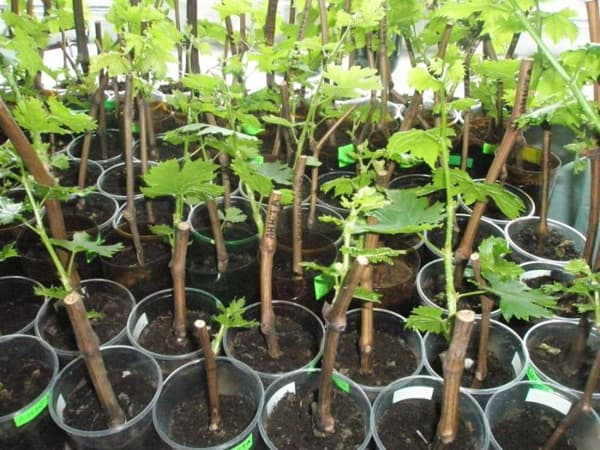
Planting stages
- For planting grapes, they dig a hole 80 cm deep, 80 cm in diameter. The height of the drainage layer is 5-7 cm (mandatory preparation stage). The next layer is filled with a mixture of fertile turf, 15-20 liters of humus and 2.5-3 liters of wood ash. This is followed by a layer of earth 5 cm high. The procedure is repeated in such a way that in the final version 5 layers are laid: drainage, fertilizer, earth, fertilizer, earth. The pit is generously filled with water (80-100 L).
- Before planting, the seedling requires preparation. The roots of the plant are pruned 24 hours before planting by a few cm. The roots should be immersed in water at room temperature. Crystals of potassium permanganate will help disinfect the surface, growth stimulants will increase the plant's immunity.
- 2-3 hours before planting, the roots are immersed in powdered clay or cow dung. As soon as the mass dries up, you can start planting.
- A peg is installed in the center of the pit, which in the future will serve as a support for young grapes.
- When placing the seedling in the hole, you need to carefully straighten the roots. Do not deeply deepen the root collar. The distance from the shoots to the ground should be 3-4 cm.
- After abundant watering (40-50 l), mulch is laid in the form of peat crumbs, humus, fresh grass.
- For the first 2-3 weeks, it is better for the seedling to stay under the protection of a white shelter (the material should not attract the sun's rays).
Important: if the goal is to create a vineyard, then the bushes should be planted at a distance of 1.5 m.A gap of 2.5-3 m remains between the rows.
Watering
For the first 2 years, the vine needs abundant and regular watering. 15-20 liters of water should be added weekly under the root. Grown plants are watered in the same amount, but twice less often. Watering is stopped during the period when the color of the berries is set. The final moisture-charging irrigation is carried out in the fall. Each plant should receive at least 70 liters of water. Watering should end with mulching.
Isabella leaves should be protected from moisture. It will not be superfluous to create a shelter over the grapes to protect from the rain. For irrigation, a drip irrigation system is built or trenches are dug between the rows, where water is poured.
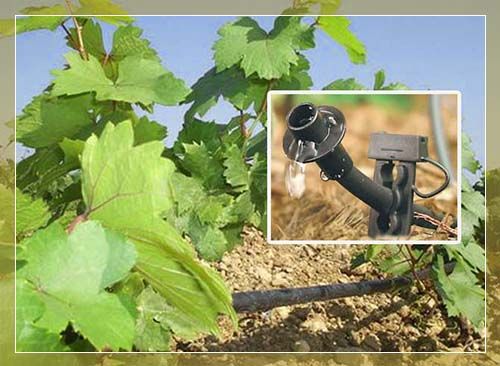

Fertilizer
- The first stage occurs in the spring. Use nitrogen-containing fertilizers.
- Re-fertilization is carried out during fruit setting. Now the plant needs potassium and phosphorus.
- At the last stage, the grapes are fed with complex preparations.
- Once every 2-3 years, the plant should be supported with natural complementary foods.
Important: in regions with unpredictable winters, Isabella needs protection from severe frosts. To do this, the vine is bent to the ground, and peat, humus or coniferous branches are placed on top. All this is covered with a covering material. It is allowed to remove the shelter only when the constant air temperature is not lower than 5 0 C.
Properties
Isabella grapes, when eaten and used in cooking, can be beneficial and harmful to the body under certain circumstances.
Calorie content
Grapes practically do not contain fats and proteins, at the same time, the sugar content in the product is much less than that of other varieties. One hundred grams of the product accounts for:
- less than a gram of fat;
- less than a gram of protein;
- about seventeen grams of carbohydrates.
Thus, the average calorie content of berries is sixty-five kilocalories. For comparison, the calorie content of Zaporozhye raisins grapes is about seventy kilocalories. It is also worth learning about the Shiraz grape variety.
Benefit and harm
The variety has gained great popularity all over the world, not only due to its simplicity in cultivation, but also due to the high content of useful properties in the composition. The antioxidants contained in berries have a beneficial effect on blood composition and prevent the development of cancerous tumors. In addition, polyphenols, flavonoids, tannins and catechins contribute to the elimination of harmful substances from the body and improve metabolism.


The fruits of this variety contain a large amount of iron, and their regular consumption contributes to a significant increase in the level of hemoglobin in the blood.
Grapes are not included in the diet during low-calorie diets due to their high sugar content. In addition, large quantities of berries cause flatulence. In some European countries, the berries of the variety are not used as raw materials for the preparation of wines, since a high concentration of methanol was found in alcoholic beverages. In addition, grapes should not be consumed when:
- increased acidity of the stomach;
- allergy tendencies;
- hypertension;
- persistent diarrhea;
- diabetes mellitus.
Acidity
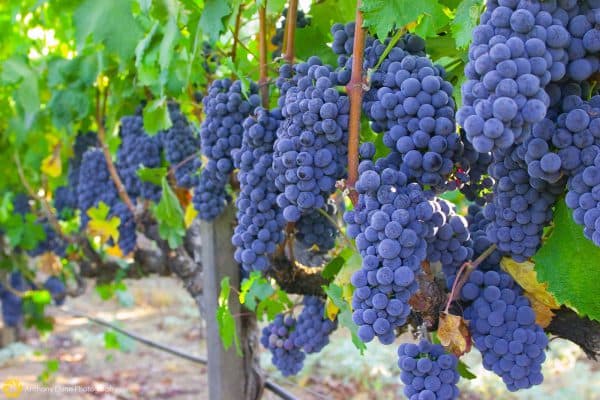

Due to the high content of vitamin C in the Isabella grape, the product has an increased acidity (about six to seven grams per liter).In this regard, the product is dangerous to use for diseases of the stomach and pancreas. In large quantities, heartburn, nausea, and abdominal pain may occur.
Learning to prune grapes
Pruning Isabella grapes in autumn is the key to proper growth of the vine, increasing the quantity and quality of the harvest. Pruning helps give the right direction for Isabella's vigorous vine.
Pruning is carried out no earlier than mid-October. First of all, weak and damaged stepchildren are removed. Shoots of the current season are cut by 1/3, lignified shoots should be 2/3 shorter. On an adult vine, 12 buds are counted, the rest must be removed.
As soon as the plants are one year old, you can start forming the vine. On a young vine, 7-8 shoots are counted, the rest is cut off. The vine should be tied so that it grows horizontally. Pay attention to the fold, it shouldn't be sharp.
Tips & Tricks
- The cut is made at a slight angle, this helps to give the right direction of the juice along the vine.
- Do not cut at the root; small bumps should be left. This will speed up the healing process.
- Each branch should have no more than 3 slices. Don't get carried away.
Let's summarize
- Isabella variety belongs to natural hybrids;
- it is distinguished by the abundance of the harvest;
- unpretentious grapes, with a high level of natural protective functions and frost-resistant properties;
- Isabella must undergo correct and timely pruning, which will have a positive effect on the harvest;
- requires shelter in regions with cold winters.
The Isabella grape has a number of benefits. It does not require a lot of experience to plant and grow it. Even a beginner will be able to harvest a rich harvest. Pruning vines in the fall should be taken with all the responsibility. Compliance with all the recommendations will allow you to cope with this task without difficulty.
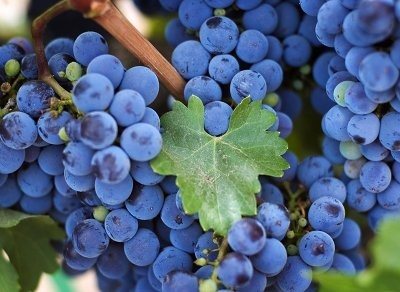

The black grape, the namesake of the Spanish queen, Isabella, is a great variety for harsh climates. Just like Krasa Severa and Super Extra, it differs high resistance to frost even without a special shelter.
Not susceptible to most grape diseases and weakly affected by pests.
The undoubted advantage of the variety is high yield comparable to the yield of the Anniversary of the Kherson Summer Resident and absolute unpretentiousness... Even a novice grower can easily grow such grapes on his site. You just need to adhere to a few simple rules and recommendations for planting and care.
Diseases
The Isabella variety is resistant to powdery mildew, phylloxera, but can get sick with mildew, anthracnose.
Anthracnose is a disease caused by a fungus. One of the first signs of damage is the appearance of black dots on the leaf plates of grapes and gray spots with a dark edging on the shoots. Subsequently, the disease can spread to flowers and berries.
The vine weakens and is unable to survive the winter.
Provoke the disease:
- excess moisture;
- lack of sun;
- lack of minerals in the soil;
- lack of the necessary maintenance of the vineyard.
To fight the infection, the affected shoots are cut off and the fallen leaves are collected and burned. The bushes are treated with Bordeaux liquid. Before wintering, prophylactic spraying with fungicidal preparations is carried out.
Mildew is one of the most dangerous grape diseases. The causative agent is the fungus Plasmopara viticola. Oily stains and whitish deposits are characteristic symptoms of the disease. If urgent measures are not taken, the plant weakens, the leaves die off, and the yield suffers. Affected berries darken, shrink and dry out. In order to prevent the development of infection, grapes are sprayed with a Bordeaux mixture even before flowering, and fertilizers containing nitrogen are used with caution.
How to plant Isabella grapes correctly?


First, you need to choose the right seedling and decide on a place for planting. It should be noted that in cold areas this variety can winter painlessly. at t up to -30 С and does not require shelter.
Isabella is a late and tall variety and for full ripening in cold climates it a warm, sunny place with a large support area is needed... You can read the full description of the variety in this article.
The ideal place for planting in this case would be placement against the wall of a house or household. the buildings. In this case, you need to plant grapes at a distance of about 1 m from the support wall.
Buy and plant grape bushes best in autumn... It can be planted in the spring, but the survival rate, in this case, will be worse. For planting, it is better to choose annual seedlings with a strong root system.
Before boarding be sure to prepare the soil... If the soil is acidic, then liming should be carried out two weeks before planting. Isabella is not picky about the composition of the earth, but will not grow on salty soil with high water table... A clay plot needs good drainage, a peat bog needs sand, and a sandy soil needs good manure.


The landing pit is prepared in advance. It should be 50-90 cm deep (depending on the soil composition) and 80 cm in diameter. At the bottom it is desirable lay a good drainage layer.
For this, any small pebbles or gravel are suitable. A small layer of dug soil is poured on top and a support peg is installed.
Then fertilize: manure, potassium salt, ash and superphosphate, add some more earth and carefully plant a bush.
Its roots are dipped in clay gruel, buried in and loosely tied up the seedling to a peg.
The land around is tamped tightly and watered abundantly. After watering, be sure to mulch the hole well with peat.
When landing in an open area, not near walls, a certain distance between plants must be observed: between the rows - at least 2 m, and between the seedlings inside the rows - about 1.5 m. With this planting scheme, it is necessary to install a special metal support for the vine.
Proper vine care
The Isabella variety is not picky about care, but nevertheless, simple rules will help to get a decent harvest and help to resist the disease. Professional gardeners advise how to care for the vine.
Isabella grapes: planting and proper care
- Timely removal of weeds and loosening of the soil;
- Timely watering: in the first few years of growth, it is recommended to build an irrigation system, then the application of water is reduced;
- When growing vines, it is necessary to apply fertilizers at least 3 times per season: in the spring, after the formation of the ovary, in the fall before wintering;
- Fertilize with humus very carefully, no more than once every few years;
- Installation of support and formation of a bush, starting from the second year of cultivation. They begin to form a bush in the spring;
- Creation of protection in the winter: you can cover Isabella with pine needles, straw or hay.
For any vine, including Isabella, an important maintenance procedure is pruning, which is carried out immediately after removing the bunches and after the plant has dropped the foliage. Caring for Isabella grapes consists in timely watering, fertilization and proper pruning. Even summer residents without experience in growing vines can take proper care of grapes.
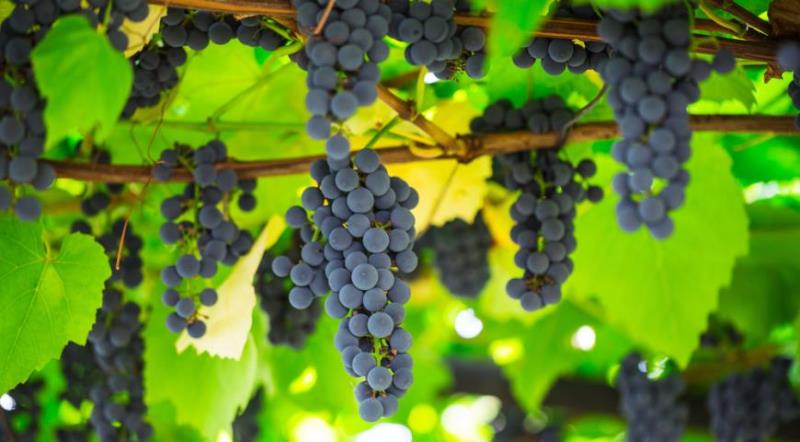

How to trim Isabella
The Isabella grape variety is pruned for mechanical damage and infections. The procedure is carried out with a very sharp pruner, carefully, trying not to catch young shoots. Isabella is trimmed at a 90 degree angle, leaving up to 12 eyes. Professionals recommend not to prune the entire vine for hibernation: this will help preserve the culture when it freezes. Isabella bushes very well and therefore requires thinning. Only a strong and healthy vine should be left. Also, before the formation of flowers, it is recommended to pinch the shoots.Grape Isabella large-fruited is ideal as an "experimental" plant for non-professional summer residents. It will be this variety that will be the first in the formation of a large vineyard in which exquisite and demanding hybrids will grow. Pruning the fragrant Isabella grapes is a must. Isabella grapes are delicious and aromatic berries that most summer residents use to make wine. Anyone can plant and grow a healthy vine: even a beginner will be able to properly care for it.
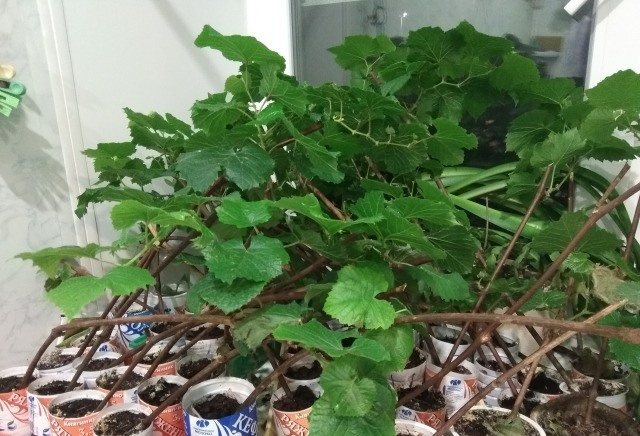

What kind of care does the variety require?
How to care for Isabella grapes? First of all, Isabella needs good watering during the period of active growth, before the appearance of berries. The frequency of watering depends on the composition of the soil: on heavy soils it is necessary to water less often, on light soils - more often. Loosening, weeding and fertilizing regularly.
Mineral fertilizers can be used no more than 3 times a year. It is good to feed with fresh manure diluted in water with the addition of superphosphate during the growth of grapes. Do not forget about thorough mulching of the soil after each watering.
In the first year after planting, the surface roots are trimmed (catarovka). In the spring, damaged and frozen shoots are removed, pinched and pinched the tops of the shoots shortly before flowering. As the shoots grow back, they must be tied to a support, giving the correct direction of growth.
Everything about the Isabella grape harvest, as well as whether this variety is suitable for wine production, can be found here.
Remember that organizing the proper care of the vines will allow you to avoid diseases such as mildew, oidium, anthracnose, various rot, rubella. Observing the rules of planting, pruning, shedding and taking other adequate measures, you can protect your plants from such misfortunes as bacterial cancer, chlorosis, bacteriosis.
You can visually familiarize yourself with the Isabella grape in the photo below:
Forming an old vine: subtleties and wisdom
So that there are no problems in the future, shaping grape bush start in the first year after planting... If this is not done, then the old vine begins to ache over time, the harvest becomes smaller and the care of such grapes becomes more difficult.
The first step is to choose the correct garter method. With a wall-mounted arrangement of grapes, supports are installed at an angle, with free placement - vertical trellises. It is important to stretch the bush over the entire trellis area to provide free access to sun and air to all parts of the vine.


The Isabella variety is not covered for the winter, so it is perfect for him
a high-standard bush shape is suitable.
To form such a bush, it is necessary to remove all stepsons located above the third step of the trellis, below - leave 2-3 stepsons and pinch the top of the shoot.
Isabella is perfect for creating arches, gazebos and pergolas. Also, maiden grapes with a full description of which you can find on our website can serve as an excellent decoration for your buildings.
The main requirement in formation is to prevent thickening of the bush. A rejuvenating pruning is carried out annually on an old vine: the entire last year's arrow with vines is removed, and the ripened annual shoots are cut into 2-4 eyes and left, with all the shoots that have grown on it, to form a new fruit link.
If you follow all these simple rules for planting and caring for Isabella grapes, then you can grow it in your summer cottage without even having special knowledge. Isabella is a wonderful grape, easy to care for, form and propagate.
You can clearly see how to properly form a bush in the video below:
If you find an error, please select a piece of text and press Ctrl + Enter.
Isabella grape belongs to hybrid varieties.Its popularity and prevalence around the world is due to its versatility and unpretentiousness. The fruits are used to prepare wine products, juices, jam, and the vine is often used to decorate the site, as an element of landscape design. Next, we will talk about the rules of cultivation and autumn pruning.
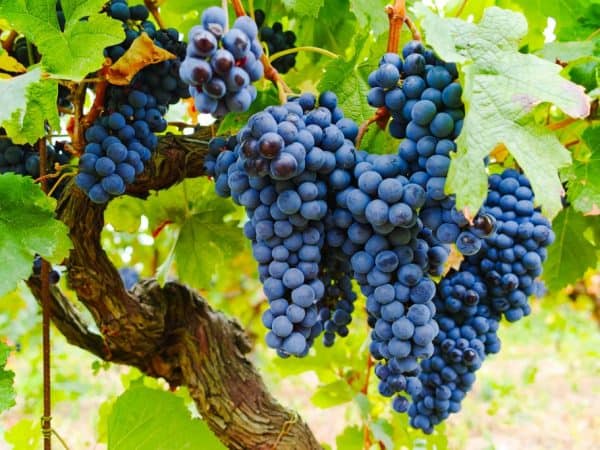

Pruning in the fall: detailed instructions
Spend autumn pruning is necessary 2-3 weeks after the leaves fall... First of all, weak and lean shoots are removed. Young bushes leave from 3 to 8 healthy shoots growing at an angle to the ground. Green stepchildren are removed completely, and woody ones - by 2/3. Cut them at right angles, as far as possible from fruiting shoots. Young shoots are pruned slightly above the location of the lower eye. Isabella has a so-called long pruning: 5-6 eyes are left on a one-year shoot. On a perennial shoot, about 1.1 eyes should be left for each mm of diameter.
It is important to follow a few pruning rules:
- make sure that the cuts are on the inside of the shoot;
- after removing annual shoots, there should be no hemp;
- the cuts must be absolutely smooth;
- an annual vine is cut 1 cm above the eye;
- shoots grown from the roots are removed at a depth of 10-15 cm underground.
Tips and tricks for anti-aging pruning
The best way to imagine how to rejuvenate an old grape bush can be illustrated by the example of three years of successive cutting off of all that is superfluous.
2 buds were left on the bush, and the rest was completely removed. During the summer, two fruit shoots grew from the buds, on which up to 20 buds were formed. They are shortened in the fall after complete leaf fall, leaving 2 buds on one and 5-6 on the second. Pruning can also be done in the spring, especially if the variety is covering. Then, in the fall, branches without foliage are removed from the trellises, carefully twisted into spirals, laid out on the ground and covered with foil. In the spring, they are examined for the identification of frozen, damaged, dried branches, which are removed first. Next, the intended shortening is performed.
Important: do formative pruning after thawing the soil, but before the first noticeable changes in the buds. If you start work when the juices are already moving, then some of them will flow out through the cut points. Such a mistake will cost up to 30% of the yield.
During the summer of the second year, both branches will give vertical shoots, on each of which buds are formed. The task of the grower is to cut off two safety shoots on a long branch, and shorten the remaining fruit shoots to 2 buds. A short branch must be cut off, leaving 2 buds on its two shoots. In the second year, the length of fruit shoots can be very large - up to 3 meters each. Sometimes it's a pity to cut so much. However, pity is not appropriate in this case. Leaving too much will prevent the bush from showing what he is really capable of. The clusters will form skinny with small sour berries.
Pruning the third year suggests two options for ennobling grapes of various varieties. The short way is for the standard ones, the long cut is for the rest.
The gardener will easily notice how the thickness of the old branches and the head of the bush will grow year after year. This is a natural process. In the oldest bushes, the base can reach truly impressive sizes. Moreover, from year to year, pruning is carried out according to the same standard scheme. There is no particular reason to change it. This is the only way to get bushes with a large number of fruit shoots that are not thickened with excess green mass.
Attention! In the summer, an operation such as chasing is performed: pruning branches on which brushes have already formed. Pruning them 20-30 cm from the brush will allow the plant not to waste energy on building up excess green mass, directing its juices to ripening berries.
Now that you know how to prune old grapes, it will be much easier to care for the vine. The grower does not need to be afraid to remove too much, because rejuvenating the vine is only beneficial. A bush with a strong root system has enough resources to restore its crown from a minimum number of buds. Long pruning of grapes is practiced to form pavilions, so common in the south, where it is important not only to grow crops, but to obtain much-needed shade.
Propagation by cuttings
How to seat? During the autumn pruning, cuttings can be prepared for planting. To do this, cut off a part of the productive annual shoot, with a diameter of about 7-10 mm and a length of 1.5-2 m.
There are 2 ways of harvesting:


The cut vine is cut into small pieces of 20-40 cm. Moreover, the upper section of the cut should be 2-3 cm above the eye.
Then the cuttings soak for 1-2 hours in a solution of ferrous sulfate and determined for storage until spring in a cold place.
For better safety, they are wrapped in a wet cloth and tied tightly in plastic bags.
In early February, the cuttings are taken out and the substrate is placed from wet coniferous sawdust.
The substrate is constantly moisturized, preventing it from drying out. After the appearance of small roots, the cuttings are planted in prepared soil of sand, compost and earth until completely rooted.
- Leaves are removed from the prepared vine, twisted into a ring and stored in a dark, cool place without additional processing. Cuttings are cut in the spring, leaving 5-6 eyes on each. After that their placed in water for 2-3 weeks and placed in a sunny warm place until roots form... Then the cuttings are rooted in a special soil using mineral fertilizers.
Such cuttings can be planted in a permanent place as early as early May.
Rules for pruning grapes
To ensure the function of fruiting the grape bush, he is left with a couple of annual vines growing on a two-year-old plant. Places of cuts should be left in one place, on the inside. To this end, the processes should be on the outside of the middle of the growth of the bush and below under the antennae.
Incorrectly placed incisions will interfere with the normal movement of the juice in the grapes. Shoots that are one year old or more are removed and half a centimeter of shoots are left in place of the cut. The size of the parts left is important, as it will affect the growth of the bush and its recovery.
Pruning grapes in autumn with photos and videos for beginners
The place of the cut of the sections that have been growing on the bush for many years should be perpendicular to the axis.
Pruning vines a year old is done between the knot a couple of centimeters from the top. It is recommended to make an incision at an angle in order to correctly direct the juice flow along the vine. Particular attention is paid to pruning the plant, the territorial location of which exposes the bush to the threat of contracting various species diseases.
The Isabella grape plant is difficult to tolerate pruning and is not able to heal damaged areas on its own.
Therefore, you should adhere to several principles:
Isabella grapes after pruning
Do not make Isabella grapes cut up and down. For each arrow of the grapes, three cutting places are enough: one is intended for the vegetative plot, the second for pruning the vine. More complete pruning should be done before the growing season is reached.
Trimming, leaving small bulges at the cut sites, helps the healing process to improve and reduce the loss of surgery. The plant is not able to heal wounds, it is not a tree, but a grape bush.Keep this in mind when it comes to pruning.
The pruning period depends on the climatic conditions of the region, if in the northern parts it is correct to clean the Isabella bush in the fall, then in the south it is better in the spring, although it is also possible in the fall. But the pruned Isabella in the south in the fall will be less able to survive the winter cold.
If the bush has taken cover, then it is best to prune after you have harvested. Both with pruning and with shelter, the timing should be correct so that the plant does not overwhelm in the shelter. But it also did not undergo severe frosts.
The harvest will be larger on strong growing bushes in the vineyard. There will not be much harvest, but the berries will have an impressive size.
You should assess the situation reasonably and be aware that large clusters on dense bushes will require a lot of physical labor and time from you to care for the plant. But you can prevent this by growing a medium Isabella bush. In summer, the main job is to remove excess shoots and bunches of grapes.
Correct pruning in the spring should be carried out timely control of the flowering of the planting material. If the inflorescences began to open, then the cleaning of the bush should be done not in the spring, but after the harvest of Isabella grapes.
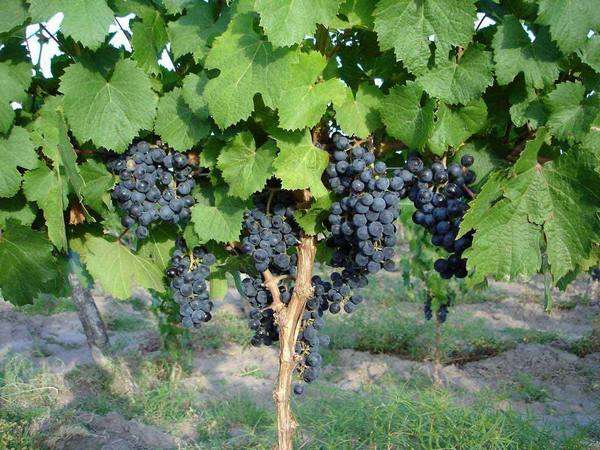

Isabella grape harvest after correct pruning
How to cover the grapes. Preparing grapes for the winter cold
The varieties developed for the middle and northern regions of Russia contributed to its advancement to the North, and today grapes form good yields both in the Urals and in the northern regions. But the genetic memory of grapes about the past still requires conditions for growing close to those where viticulture originated: the required amount of heat temperatures, sufficient lighting and shelter from the late autumn and winter cold. Temperature changes more often cause the death of immature vines and young seedlings.
Experienced winegrowers in their household arsenal have a whole range of winter covering devices: spunbond, burlap, mats, straw, nets, wooden shelves, boards, etc.
Depending on the region of cultivation, the duration of cold weather, snow cover, spring and autumn weather conditions, different types of shelters are used to shelter vineyards in summer cottages and house plots.
Grape bushes must be prepared for shelter. Otherwise, rodents can gnaw the roots and vines, mold and other fungal diseases will appear on improperly covered lashes, eyes will die, etc.
To properly prepare the bushes for wintering, you must perform the following preparatory work:
- In dry autumn, water the grape bushes abundantly.
- In September, the grape bushes should be fed with potash or phosphorus-potassium fertilizers.
- After the leaves have fallen, prune the unripe vine. It is green or greenish in color. An unripe vine always freezes in winter.
- In addition to sanitary pruning of unripe grape shoots, form a load, leaving 2-3 buds above the norm for spring control.
- Treat the grape bushes with a 3% solution of copper or iron sulfate, solutions of other drugs for diseases and pests.
- Prepare the aboveground part of the vines for shelter. Remove from the wire, tie the shoots into loose bundles.
- Prepare trenches (if provided by technology) for laying grape vines for shelter.
- Prepare covering material.

